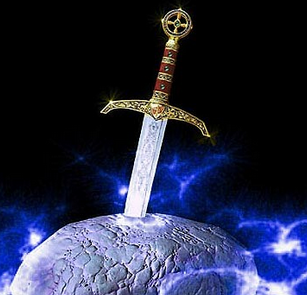
When we think of the story of King Arthur—an English squire who pulls a sword from the stone to become King of England—we think we know it all, right? But there are so many stories to draw from, so many bits and pieces that have gone into it, it makes your head spin.
When I began researching for my thirteenth Crispin Guest Medieval Noir Mystery, SWORD OF SHADOWS, I wanted to have my medieval detective somehow associated with King Arthur and on a (hired) quest to find the sword of swords, Excalibur. I knew that the Arthurian legends were older than I suspected they were, and indeed, we must go back…farther than the play Camelot, all the way back to Welsh and Irish folklore.
In the Welsh tales, Arthur was a pagan who moved through a magical realm, dodging enemies with the help of wizards and swordsmanship. In later Welsh and Irish mythology, Arthur seems to be a semi-divine figure that easily transitions to the later medieval chivalric romances where the knights of the Roundtable could fit easily into the story.
A ninth century Welsh cleric called Nennius was the first to wrestle the varying Arthur stories into one narrative, though he cheated a bit by wedging Arthur into the history between the end of Roman Britain and his own time period–which might be closer to some kind of historical fact than some of the others who wrote about Arthur. Now Nennius’ Arthur was not a king but a Christian warrior waging war against the pagans.

But with the popularity of Tristan and Isolde, in Cornwall the focus was on sixth century King Mark—the uncle to Tristan—rather than King Arthur. The court of Tristan and Isolde was said to be at Tintagel in Cornwall…which later became the birthplace of Arthur, perhaps piggy-backing on an already beloved tale…and the place I wanted to set my medieval mystery.
In the 1100s, Geoffrey of Monmouth, a English cleric who lived near Wales and no doubt heard these tales, began his History of the Kings of Britain from Nennius. But he built up Arthur as the King of British Kings. He was writing a HISTORY, after all, and needed to give it some provenance, excitement, and weight.
Over in France, Arthur and his knights hit the right note. They loved him there! And let’s face it, King Henry II of England and his wife Eleanor of Aquitaine spent a lot of time running England from France. And even Eleanor’s daughter from King Louis VII of France, Marie de Champagne, commissioned poet Chrétien de Troyes in the 1100s to write the story of Launcelot as a chivalric tale of courtly love, but because de Troyes was such a fuddy-duddy, she got Godefroi de Leigni to finish the torrid love triangle we know today. So you see, Launcelot came late to the story, but because it leant an air of romance and high drama—what with a treasonous love triangle—it sort of stuck in the imagination. Now, instead of a pagan-divine-Christian-king, he was a man speaking of loyalty, but being betrayed by those he loved best.

Now bring in Excalibur. A king must have a sword. The name Excalibur derives from the Welsh Caledfwlch and Cornish Calesvol, Latinized into Caleburnus and in Old French it is Escalibor and finally the familiar Excalibur.
The most familiar story is from the twelfth/early thirteenth century French poet Robert de Boron‘s Merlin, the first tale to mention the “sword in the stone” motif. Merlin places a sword in an anvil sitting atop a stone that appeared in a churchyard on Christmas Eve (that’s what brings it back to Christianity among all that pagan stuff like wizards and nymphs) and that’s how Arthur becomes king because only the true king can pull it from the stone. Or so Merlin says.
What we know about Arthur generally comes from Thomas Mallory’s Le Morte D’Arthur (the musical Camelot was based on T. H. White’s The Once and Future King, which was based on Mallory) and that is from 1470, well after my detective Crispin’s time. And Tennyson’s Idylls of the Kings is even later. So put yourself in the fourteenth century, when these stories were actual histories to the medieval mind, not fairy tales. The ‘real’ Arthur—one single man—likely never existed, but we may never know. You’ll have to read SWORD OF SHADOWS to see what my detective adds to the tale.

A quest to find the ancient sword Excalibur quickly turns into a hunt for a determined killer for Crispin Guest.
London, 1396. A trip to the swordsmith shop for Crispin Guest, Tracker of London, and his apprentice Jack Tucker takes an unexpected turn when Crispin crosses paths with Carantok Teague, a Cornish treasure hunter. Carantok has a map he is convinced will lead him to the sword of Excalibur – a magnificent relic dating back to King Arthur and the Knights of the Round Table – and he wants Crispin to help him find it.
Traveling to Tintagel Castle in Cornwall with Carantok and Jack, Crispin is soon reunited with an old flame as he attempts to locate the legendary sword. But does Excalibur really exist, or is he on an impossible quest? When a body is discovered, Crispin’s search for treasure suddenly turns into a hunt for a dangerous killer.
Amazon.com: https://www.amazon.com/Sword-Shadows-Crispin-Guest-Mystery-ebook/dp/B083M5RHRT/
Amazon.uk: https://www.amazon.co.uk/Sword-Shadows-Crispin-Guest-Mystery-ebook/dp/B083M5RHRT/
Meet Jeri Westerson:

Jeri Westerson writes the Crispin Guest Medieval Noir series, standalone historicals, the paranormal series Booke of the Hidden, Moonrisers; A Werewolf Mystery Series, and a steampunk/historical fantasy series the Enchanter Chronicles. See them all at JeriWesterson.com